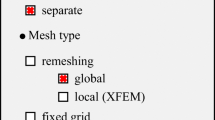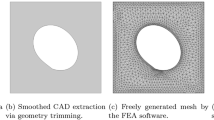Abstract
Topology optimization of fluid flow problems is still a challenging open problem, especially when considering turbulence, compressibility, or the addition of different physics. In the current implementation of topology optimization for fluids considering density methods, there are essentially three problems. First, the grayscale in the result makes it difficult to identify the precise contour of the fluid region, which may be a problem in some applications and during the optimization process as well. Second, even for low Reynolds flow design problems, a continuation scheme of the material model penalization parameters is necessary to avoid a grayscale and to obtain a clear boundary. Third, in complex fluid flow optimization problems, it is difficult to specify the maximum value of the inverse permeability to avoid the fluid to flow inside the solid. This work proposes a novel methodology that tackles the first two problems, i.e., it avoids the grayscale and obtains clear boundaries. The goal of this work is to implement the Topology Optimization of Binary Structures (TOBS) (Sivapuram and Picelli, Finite Elem Anal Des 139:49–61, 2018) for fluid flow design, which is a novel topology optimization method that has been used in solid mechanics to generate optimized structural solutions considering only binary {0,1} design variables. The main advantage of {0,1} methods is the clear definition of the interface and the absence of grayscale. It is a method easy to implement which preserves the material distribution features. Some classic fluid problems are considered to illustrate the problem, such as the double channel and the bend pipe, and also a more complex example that usually presents grayscale issues, which is the fluid diode design. The optimization results show the feasibility of the TOBS when applied to fluid flow problems. The physical problem is solved by using the finite element method and the optimization problem with CPLEXⒸ, a proprietary optimization package from IBM. The present work successfully eliminates the grayscale problem, bringing clear boundaries in the interface fluid-solid.




































Similar content being viewed by others
References
Alonso DH, de Sá LFN, Saenz JSR, Silva ECN (2018) Topology optimization applied to the design of 2d swirl flow devices. Struct Multidiscip Optim 58(6):2341–2364
Andreasen CS, Gersborg AR, Sigmund O (2009) Topology optimization of microfluidic mixers. Int J Numer Methods Fluids 61(5):498–513
Beckers M (1999) Topology optimization using a dual method with discrete variables. Struct Multidiscip Optim 17:14–24
Borrvall T, Petersson J (2003) Topology optimization of fluids in Stokes flow. Int J Numer Methods Fluids 41:77–107
Challis VJ, Guest JK (2009) Level set topology optimization of fluids in stokes flow. Int J Numer Methods Eng 79(10):1284–1308
Dilgen CB, Dilgen SB, Fuhrman DR, Sigmund O, Lazarov BS (2018) Topology optimization of turbulent flows. Comput Methods Appl Mech Eng 331:363–393. https://doi.org/10.1016/j.cma.2017.11.029
Ejlebjerg Jensen K, Szabo P, Okkels F (2012) Topology optimization of viscoelastic rectifiers. Appl Phys Lett 100(23):234,102
Evgrafov A (2006) Topology optimization of slightly compressible fluids. ZAMM-Journal of Applied Mathematics and Mechanics/Zeitschrift für Angewandte Mathematik und Mechanik 86(1):46–62
Feppon F, Allaire G, Bordeu F, Cortial J, Dapogny C (2019) Shape optimization of a coupled thermal fluid-structure problem in a level set mesh evolution framework. SeMA Journal 76(3):413–458
Gersborg-Hansen A, Sigmund O, Haber RB (2005) Topology optimization of channel flow problems. Struct Multidiscip Optim 30(3):181–192
Haftka RT, Gürdal Z (1991) Elements of structural optimization, 3rd edn. Kluwer Academic Publishers, Dordrecht
Liang Y, Cheng G (2020) Further elaborations on topology optimization via sequential integer programming and canonical relaxation algorithm and 128-line MATLAB code. Struct Multidiscip Optim 61:411–431
Lin S, Zhao L, Guest JK, Weihs TP, Liu Z (2015) Topology optimization of fixed-geometry fluid diodes. J Mech Des 137(8)
Olesen LH, Okkels F, Bruus H (2006) A high-level programming-language implementation of topology optimization applied to steady-state Navier–Stokes flow. Int J Numer Methods Eng 65(7):975–1001
Picelli R, Ranjbarzadeh S, Sivapuram R, Gioria RS, Silva ECN (2020a) Topology optimization of binary structures under design-dependent fluid-structure interaction loads. Struct Multidiscipl Optim 62:2101–2116
Picelli R, Sivapuram R, Xie YM (2020b) A 101-line MATLAB code for topology optimization using binary variables and integer programming. Struct Multidiscipl Optim. https://doi.org/10.1007/s00158-020-02719-9
Pingen G, Maute K (2010) Optimal design for non-newtonian flows using a topology optimization approach. Computers & Mathematics with Applications 59(7):2340–2350
Romero J, Silva E (2014) A topology optimization approach applied to laminar flow machine rotor design. Comput Methods Appl Mech Eng 279:268–300
Sá LFN, Amigo RCR, Novotny AA, Silva ECN (2003) Topological derivatives applied to fluid flow channel design optimization problems. Struct Multidiscipl Optim. https://doi.org/10.1007/s00158-016-1399-0
Sá LFN, Romero J, Horikawa O, Silva E (2018) Topology optimization applied to the development of small scale pump. Struct Multidiscip Optim 57(5):2045–2059
Sá LFN, Yamabe PV, Souza BC, Silva EC (2021) Topology optimization of turbulent rotating flows using Spalart–Allmaras model. Comput Methods Appl Mech Eng 373:13,551. https://doi.org/10.1016/j.cma.2020.113551
Sivapuram R, Picelli R (2018) Topology optimization of binary structures using integer linear programming. Finite Elem Anal Des 139:49–61
Sivapuram R, Picelli R (2020) Topology design of binary structures subjected to design-dependent thermal expansion and fluid pressure loads. Struct Multidiscip Optim, pp 1–19
Sivapuram R, Picelli R, Xie YM (2018) Topology optimization of binary microstructures involving various non-volume constraints. Comput Mater Sci 154:405–425. https://doi.org/10.1016/j.commatsci.2018.08.008
Song XG, Wang L, Baek SH, Park YC (2009) Multidisciplinary optimization of a butterfly valve. ISA Transactions 48(3):370–377
Svanberg K, Werne M (2006) Topology optimization by sequential integer linear programming. Springer, Dordrecht
Williams HP (2009) Logic and integer programming. Springer, Boston
Yoon GH (2016) Topology optimization for turbulent flow with Spalart–Allmaras model. Comput Methods Appl Mech Eng 303:288–311
Acknowledgements
All authors gratefully acknowledge the support from BG/Shell Brasil and FAPESP through the Research Centre for Gas Innovation - RCGI (Fapesp Proc. 2014/ 50279-4), hosted by the University of Sao Paulo, and the strategic importance of the support given by ANP (Brazil’s National Oil, Natural Gas and Biofuels Agency) through the R&D levy regulation.
The last author thanks the financial support of CNPq (National Council for Research and Development) under grant 302658/2018-1. The fourth and the fifth author would like to thank the support of FAPESP (São Paulo Research Foundation), grants 2018/05797-8, 2019/01685-3 and 2018/11474-7.
Author information
Authors and Affiliations
Corresponding author
Ethics declarations
Conflict of interest
The authors declare that they have no conflict of interest.
Additional information
Responsible Editor: YoonYoung Kim
Publisher’s note
Springer Nature remains neutral with regard to jurisdictional claims in published maps and institutional affiliations.
Replication of results
All the data to be reproduced are available on http://github.com/bruno-caldas/tobs.
Rights and permissions
About this article
Cite this article
Souza, B.C., Yamabe, P.V.M., Sá, L.F.N. et al. Topology optimization of fluid flow by using Integer Linear Programming. Struct Multidisc Optim 64, 1221–1240 (2021). https://doi.org/10.1007/s00158-021-02910-6
Received:
Revised:
Accepted:
Published:
Issue Date:
DOI: https://doi.org/10.1007/s00158-021-02910-6




